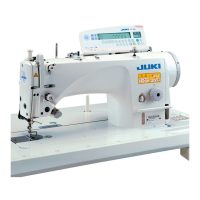
Do you have a question about the JUKI DLN-9010 and is the answer not in the manual?
| Motor | Direct-drive servomotor |
|---|---|
| Max Sewing Speed | 5, 000 stitches per minute |
| Needle Type | DPx5 |
| Lubrication | Automatic |
| Dimensions | 580 x 220 x 370 mm |
| Weight | 38 kg |
Explains the meaning of danger, warning, and caution symbols and their severity levels.
Describes the meaning of warning pictograms and labels used on the machine.
Lists essential safety guidelines to follow before operating the sewing machine.
Outlines fundamental steps and considerations for safe machine operation.
Refers to safety devices and warning labels for proper machine operation.
Core safety practices to follow when using the machine.
Stresses that the machine must be operated by trained personnel only.
Lists specific situations requiring the power switch to be turned off.
Specifies that only trained technicians should perform repairs using JUKI designated parts.
Requires qualified technicians for electrical component repair and maintenance.
Stresses the necessity of grounding the machine for normal operation.
States that the machine is only allowed for its intended purpose.
Details the machine's technical specifications including application, speed, and needle type.
Specifies the type of lubricating oil and the noise level during operation.
Step-by-step guide for attaching the machine's under cover to the table.
Crucial safety warning to turn off the power before performing knee lifter adjustments.
Step-by-step instructions for adjusting the height of the knee lifter mechanism.
Guide to assembling the thread stand unit and attaching it to the machine table.
Crucial safety instruction to turn off the power before performing lubrication.
Steps for filling the oil tank for hook lubrication with JUKI New Defrix Oil No.1.
Detailed steps for adjusting the oil quantity supplied to the hook.
Specific instructions for using RP hooks, including oil level adjustments.
Recommended break-in procedure for new or infrequently used sewing machines.
Description of the special paper used for confirming oil splashes.
Detailed steps for checking oil splashes, including machine operation and timing.
Visual reference for the correct small oil amount for DLN-9010SS/SH.
Visual reference for the correct large oil amount for DLN-9010SS/SH.
Crucial safety warning to turn off power before attaching the needle.
Step-by-step guide for correctly installing the needle into the machine.
Advises on needle insertion angle when using filament thread to prevent issues.
Steps for adjusting stitch length using the stitch length dial and feed lever.
How to adjust the pressure required to depress the front and back parts of the pedal.
Method to adjust the pedal's stroke length by changing the connecting rod position.
Crucial safety warning to turn off power before threading the machine head.
Step-by-step guide for threading the upper thread through the machine head.
How to properly insert the bobbin into the bobbin case with correct thread orientation.
How to adjust the amount of thread wound onto the bobbin.
Guide for adjusting the tension of the upper needle thread using tension nuts.
Instructions for adjusting the tension of the lower bobbin thread using the tension screw.
How to adjust the stroke length of the thread take-up spring by moving the tension post.
How to adjust the pressure of the thread take-up spring by adjusting the tension post.
Procedure to adjust the needle's stop position after thread trimming.
Critical warning not to operate the machine with the setscrew loosened.
How to adjust the pressure required to depress the front and back parts of the pedal.
Method to adjust the pedal's stroke length by changing the connecting rod position.
Steps for installing the connecting rod to ensure proper alignment.
How to adjust the pedal's tilt angle by modifying the connecting rod length.
Describes the four distinct stages of pedal operation for sewing, stopping, and trimming.
Instructions on how to use the switch lever to perform reverse feed stitching.
How to adjust the switch's height and position by loosening screws.
Lists the functions that can be performed with the optional switch.
Guide to connecting the optional switch cord to the machine head connector.
Procedure to adjust the wiper's position based on fabric thickness.
Step-by-step guide to synchronize the needle and hook timing correctly.
Warnings regarding the consequences of incorrect needle-hook clearance.
Instructions for resharpening a dull counter knife and reinstalling it properly.
Step-by-step guide to adjust the height and tilt of the feed dog.
Steps to adjust feed timing, including loosening screws and turning the eccentric cam.
Recommended feed timing settings for SS and SH type machines based on graduation alignment.
Step-by-step instructions for releasing thread tension using the mechanism.
Step-by-step instructions for adjusting the micro-lifting screw.
Warning about adjusting the screw height when the mechanism is not in use to avoid reduced feed force.
Notes that DLN-9010 has a standard micro-lifting mechanism that is tool-free.
How to adjust the presser foot height and angle by loosening the clamp screw.
How to achieve standard stitch width by aligning crank and regulator block markers.
Procedure to increase needle feed amount over feed dog amount by adjusting regulator block.
Steps to switch the machine from needle feed to bottom feed mode.
Steps to switch the machine from bottom feed to needle feed mode.
Instructions for installing the throat plate, feed dog, and presser foot for needle feed.
How to adjust the feed dog's longitudinal position for needle feed, aligning needle hole with needle center.
How to adjust bottom feed timing by fixing the cam and turning the handwheel.
How to align needle eyelet and feed dog top surface for standard bottom feed timing.
How to reset the thread trimmer cam by aligning pulley cover marker with handwheel marker.
Steps for installing the hook and bobbin case positioning finger.
Instructions for mounting the machine's face plate.
Final check to ensure no contact between components at max dial setting.
